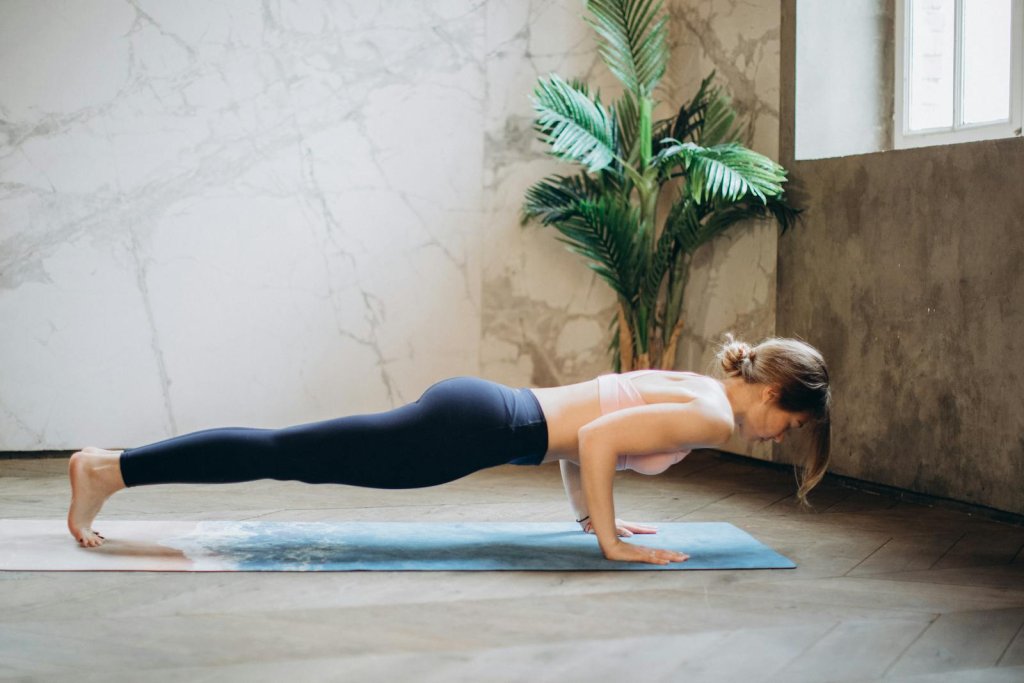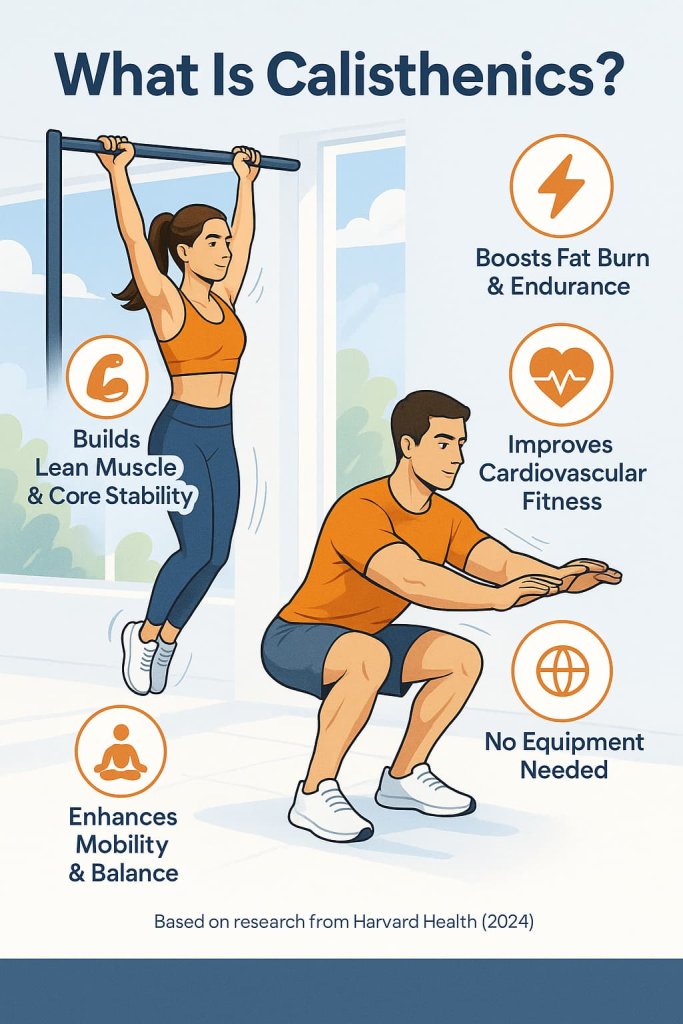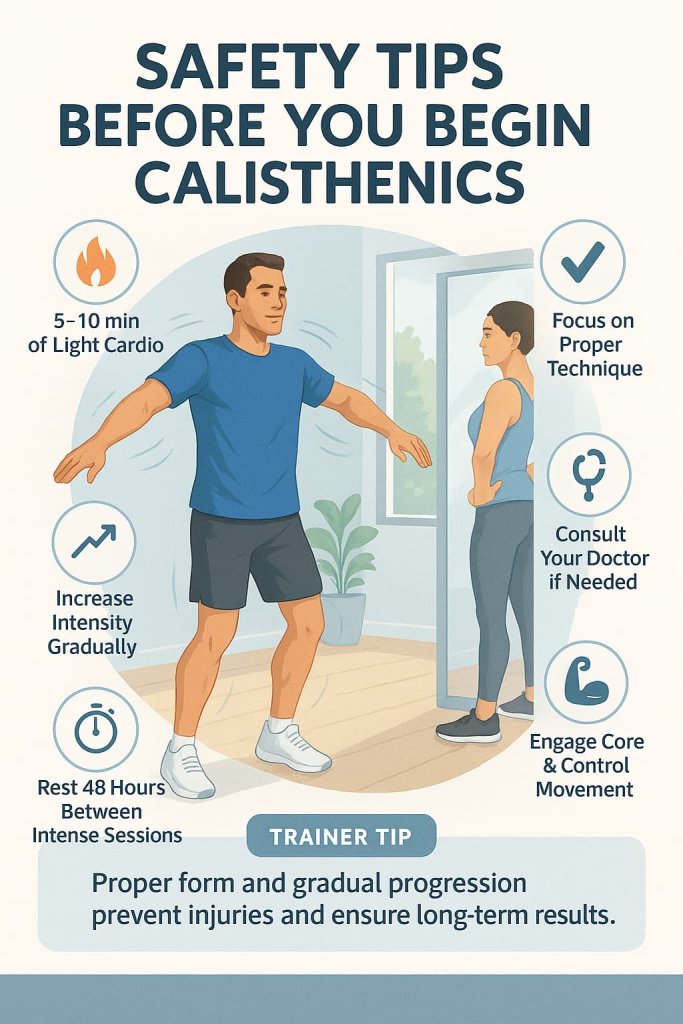Calisthenics workouts at home are one of the most effective and accessible ways to build strength, burn fat, and improve flexibility—without needing any gym equipment.
These bodyweight exercises rely on controlled movement and resistance to sculpt lean muscle, enhance mobility, and boost endurance.

Understanding how to train with calisthenics is crucial for anyone seeking long-term, sustainable fitness. It’s inexpensive, convenient, and adaptable to all fitness levels—from beginners to athletes. With just your bodyweight and some consistency, you can achieve powerful results at home.
This guide covers the 12 best calisthenics exercises, key benefits, safety tips, and how to create a home workout plan for total-body transformation.
What Is Calisthenics?
Calisthenics is a form of resistance training that uses your bodyweight as the load instead of dumbbells or machines. Common movements include push-ups, squats, planks, and pull-ups.

According to Harvard Health (2024), calisthenics improves muscular strength, flexibility, and endurance while enhancing cardiovascular health. It’s a “low-frills” but highly efficient way to stay fit and functional.
Key Benefits:
- Builds lean muscle and core stability
- Enhances flexibility and mobility
- Improves coordination and balance
- Increases energy expenditure and fat loss
- Boosts overall athleticism
Safety Tips Before You Begin

Before starting your calisthenics journey:
- Warm up for 5–10 minutes with light cardio (jumping jacks, arm swings, or squats).
- Use proper form—quality matters more than quantity.
- Start slow and increase difficulty progressively.
- Avoid overtraining—allow 48 hours between intense sessions.
- Consult a healthcare professional if you have joint, heart, or balance concerns.
Trainer Tip: Maintain a neutral spine, engage your core, and focus on smooth, controlled movements.
12 Best Calisthenics Workouts at Home
Below are the top home-friendly calisthenics exercises targeting all major muscle groups.
1. Push-Ups
Why it works:
Push-ups engage multiple upper-body muscles simultaneously, making them one of the most efficient strength builders. They develop chest, shoulder, triceps, and core stability while improving functional pushing power for daily activities.
Muscles worked:
Pectoralis major, triceps brachii, anterior deltoids, and core stabilizers.
How to do it:
- Place your hands slightly wider than shoulder-width apart.
- Keep your body in a straight line from head to heels.
- Lower your chest until it nearly touches the floor.
- Push back up, maintaining a tight core throughout.
Trainer Tip:
If you’re a beginner, start with knee or incline push-ups. To progress, try diamond or decline push-ups for more intensity.
2. Bodyweight Squats
Why it works:
Squats strengthen the lower body, improve mobility, and boost metabolism. They also enhance balance and joint health, making them essential for daily movement.
Muscles worked:
Quadriceps, glutes, hamstrings, calves, and core.
How to do it:
- Stand with feet shoulder-width apart.
- Push hips back and bend knees as if sitting into a chair.
- Lower until thighs are parallel to the ground.
- Drive through your heels to stand back up.
Trainer Tip:
Keep your knees aligned with your toes and avoid rounding your back. For extra challenge, try jump squats or add a pause at the bottom.
3. Pull-Ups (or Doorway Rows)
Why it works:
Pull-ups develop a strong back and arms, improving posture and grip strength. They are among the best bodyweight exercises for overall upper-body strength.
Muscles worked:
Latissimus dorsi, biceps, rhomboids, and trapezius.
How to do it:
- Grip a pull-up bar with palms facing away.
- Engage your core and pull your chin above the bar.
- Lower yourself slowly under control.
(Alternative: perform inverted rows under a sturdy table.)
Trainer Tip:
If you’re new, use a resistance band or do negative reps to build strength progressively.
4. Plank Hold
Why it works:
Planks build core stability and protect your spine by strengthening deep abdominal and postural muscles.
Muscles worked:
Rectus abdominis, obliques, lower back, shoulders, and glutes.
How to do it:
- Lie face down and lift onto forearms and toes.
- Keep your body straight, core tight, and neck neutral.
- Hold for 30–60 seconds.
Trainer Tip:
Avoid sagging hips or arching your back. Gradually increase your hold time as you build endurance.
5. Lunges
Why it works:
Lunges improve lower-body strength, stability, and unilateral balance—helping correct muscle imbalances between legs.
Muscles worked:
Glutes, hamstrings, quadriceps, and calves.
How to do it:
- Stand tall, step forward with one leg.
- Lower until both knees form 90° angles.
- Push back through your front heel to return.
- Alternate legs.
Trainer Tip:
Keep your torso upright and avoid letting your front knee move past your toes.
6. Dips (Chair or Parallel Bars)
Why it works:
Dips are excellent for building arm and upper-body pushing strength without weights.
Muscles worked:
Triceps, anterior deltoids, and lower pectorals.
How to do it:
- Place your hands on the edge of a sturdy chair.
- Walk your feet forward and lower yourself by bending elbows to 90°.
- Push back up, keeping your chest lifted.
Trainer Tip:
Don’t flare your elbows out—keep them close to your torso for better joint safety.
7. Mountain Climbers
Why it works:
This dynamic movement boosts heart rate, burns calories, and builds endurance while engaging the core and lower body.
Muscles worked:
Abs, hip flexors, shoulders, chest, and legs.
How to do it:
- Start in a plank position.
- Drive one knee toward your chest, then switch quickly.
- Continue alternating at a steady rhythm.
Trainer Tip:
Keep your hips level and core tight to maximize stability and calorie burn.
8. Jump Squats
Why it works:
Jump squats combine strength and power, training fast-twitch muscle fibers for explosiveness and athletic performance.
Muscles worked:
Quadriceps, glutes, hamstrings, and calves.
How to do it:
- Perform a regular squat.
- Explosively jump upward.
- Land softly, lowering back into a squat position immediately.
Trainer Tip:
Focus on a controlled landing—knees slightly bent—to protect your joints.
9. Glute Bridges
Why it works:
This movement isolates and strengthens the glutes, improving hip stability and lower-back health.
Muscles worked:
Gluteus maximus, hamstrings, and lower back.
How to do it:
- Lie flat with knees bent and feet flat on the floor.
- Lift your hips until your shoulders, hips, and knees form a straight line.
- Lower slowly without letting hips touch the ground.
Trainer Tip:
Squeeze your glutes at the top and avoid arching your lower back.
10. Pike Push-Ups
Why it works:
A great upper-body move that targets shoulders and mimics an overhead press using your body weight.
Muscles worked:
Deltoids, triceps, upper chest, and core.
How to do it:
- Begin in a downward dog position.
- Bend elbows to lower your head toward the floor.
- Push back up to starting position.
Trainer Tip:
Keep your elbows at a 45° angle to reduce shoulder strain. Progress to handstand push-ups when ready.
11. Leg Raises
Why it works:
Leg raises strengthen lower abs and hip flexors, improving core stability and posture.
Muscles worked:
Rectus abdominis, hip flexors, and obliques.
How to do it:
- Lie flat with hands under your hips.
- Lift legs together to a 90° angle.
- Lower slowly without touching the floor.
Trainer Tip:
Press your lower back into the mat to avoid strain and keep movements slow and controlled.
12. Burpees
Why it works:
Burpees combine strength and cardio in one explosive move, boosting endurance and total-body conditioning.
Muscles worked:
Chest, shoulders, arms, core, glutes, and legs.
How to do it:
- Stand tall, then drop into a squat.
- Kick legs back into a plank.
- Perform a push-up (optional).
- Return to squat and jump straight up.
Trainer Tip:
Focus on smooth transitions and maintain proper form. Don’t sacrifice technique for speed.
How to Create a Home Calisthenics Routine
Beginner Plan (3x per week):
- 10 push-ups
- 15 squats
- 20-second plank
- 10 lunges per leg
- 10 glute bridges
Repeat 2–3 rounds.
Intermediate Plan (4x per week):
- 15–20 push-ups
- 20 jump squats
- 30-second plank
- 10–12 pull-ups or rows
- 10–15 dips
Repeat 3–4 rounds.
Advanced Plan (5x per week):
Include handstand push-ups, pistol squats, and muscle-ups.
Health Benefits of Calisthenics
Research shows that consistent calisthenics training:
- Improves strength and muscle thickness comparable to weightlifting (PubMed, 2018)
- Enhances mobility, balance, and neuromuscular control (PMC, 2022)
- Supports metabolic health and body composition (Cleveland Clinic, 2025)
Common Mistakes to Avoid
- Skipping warm-ups or cool-downs
- Overtraining without recovery
- Poor posture (rounded back, flared elbows)
- Ignoring progressive overload (increase reps/time weekly)
FAQ
1. Can I build muscle with calisthenics only?
Yes, studies show that progressive bodyweight exercises can build significant muscle mass and strength.
2. How many days a week should I train?
Aim for 3–5 days weekly, alternating muscle groups to recover effectively.
3. Do I need equipment for calisthenics?
No, though a pull-up bar or resistance bands can expand your exercise options.
4. How long until I see results?
With consistency, visible results can appear within 4–8 weeks.
5. Are calisthenics good for fat loss?
Yes, combining strength and cardio movements increases calorie burn and fat loss.
6. Can beginners do calisthenics safely?
Absolutely—start with modified moves (knee push-ups, wall planks) and progress gradually.
7. Should I stretch after workouts?
Yes, stretching improves flexibility, reduces soreness, and aids recovery.
Conclusion
Calisthenics workouts at home offer one of the most effective and sustainable paths to fitness. They build muscle, enhance balance, and burn fat—no gym required.
Start with simple exercises, focus on form, and gradually increase your intensity for lasting results.
Ready to get started?
Commit to three sessions this week and see how strong you can become—right from your living room.
References
- Mear et al., 2022 (Open Access, PMC) — Breaking up sedentary time with calisthenics
4-week intervention showing improved strength, balance, and neuromuscular function.
https://pmc.ncbi.nlm.nih.gov/articles/PMC9653850/ - ACSM Position Stand (Med Sci Sports Exerc., 2011) — Quantity and quality of exercise
Gold-standard programming targets (frequency, intensity, volume) for resistance/flexibility.
https://pubmed.ncbi.nlm.nih.gov/21694556/ - WHO Guidelines on Physical Activity and Sedentary Behaviour (2020)
Authoritative weekly activity recommendations to ground your “Safety” and “Programming” H2s.
https://www.who.int/publications/i/item/9789240015128 - van den Tillaar et al., 2019/2020 series (Open Access, PMC) — Push-ups vs bench press
Evidence that push-ups can mimic bench-press demands (activation/kinematics) for strength gains.
https://pmc.ncbi.nlm.nih.gov/articles/PMC6728153/ - Alizadeh et al., 2020 (Open Access, PMC) — EMG & performance: push-ups vs bench press
Useful for progression logic (incline → standard → loaded) in your exercise list.
https://pmc.ncbi.nlm.nih.gov/articles/PMC7196742/ - ACE (American Council on Exercise) — Activity-specific warm-up & mobility drills
Practical, evidence-informed warm-up guidance to support your Safety section.
https://www.acefitness.org/certifiednewsarticle/2910/a-detailed-guide-to-designing-activity-specific-warm-up-and-mobility-drills/
